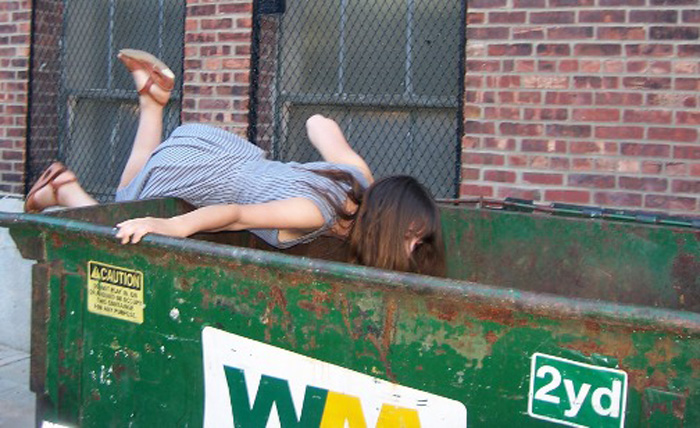Urban Foraging

The new urban trend “urban foraging” is getting more and more popular. Foraging describes the act of looking or searching for food. Urban foragers are looking for food in urban areas. Critics may say that this orginal way of wandering around and searching for food isn´t necessary in our globalized, western civilized world, because there are supermarkets on every corner where you can get everything you need fast and cheap than instead of walking around in urban areas and looking for food.
But that is exactly what “urban foragers” don´t like about our food system. In our consumption-orientied society a lot of people forgetting about (or event don´t know) where the food we are eating comes from or don´t care about it. But even worse is the lack of understanding for the wastage of food: food gets thrown away although it is still good and edible. According to a study of the UN, more than 1.3 billion tons of food is thrown away every year-which is more than one third of all food. This waste of food doesn´t just mean a wastage of food which could feed a lot of people, it also contributes a hugh waste of water, land use, carbon emsissions, pollution, extermination of fish and our environment.
Urban foraging combines two social movements: freeganism and drifting.
Freeganism is a anti-consumerism practice which comes from the anti-globalization and environmentalist movement. Freegans are againt the throwaway society and try “to boycott products from unethical corporations responsible for human rights violations, environmental destruction and animal abuse”. Freegans want to minimize their ecological footprint.
Drifting describes the wandering and floating around in urban area and getting inspired by the places you see. Drifting leads you to places you have never been to before and exploring cities in a different manner.
In the following InEnArt will present you some urban foraging practices:
Dumbster Diving/ Garbage Picking
Dumbster Diving is the process of scavenging in dumpsters for still edible food, mostly from dumbsters in front of supermarkets or factorys. Stores throw out large amounts of aesthetically damaged goods like bruised fruit or crushed boxes. They also discard products that have reached their sell-by date. And all that is going to the trash, although it is still good.
“Dumbster Diver” or “Garbage Picker” would describe their practice as money-saving hobby, a kind of sport or as a an environmentally and socially conscious way of living and a political standpoint. Nevertheless it also practised from people in need.
What first may sounds disgusting, unhealty, risky, danergerous or illegal– which it all can be, if you do it wrong, is also a statement for anti-consumerism and against the affluent society.
An instruction of how to dumbster dive, can be found here.
Fallen Fruit
Fallen Fruit is the artist collaboration of David Burns, Matias Viegener and Austin Young. Their work focuses on urban space, neighbourhood and society as well as community with a relation to fruit. Often it is about the issue of social justice, enviroment, public and private property, and the question of what public space might be used for. They expand their research of public art by creating forms of art that might exist with and in the public that are not in the traditional forms of public art, like a sculpture or “common” urban art like graffiti.
Using photography and video for their work they also create public projects, site-specific installations, performances ans happenings in various cities around the world.
A project of them is “Public Fruit Jams”, to which they invite a broad public to transform homegrown or public fruit and join in communal jam-making as experimentation in personal narrative and sublime collaboration. “Urban Fruit Action” is a work where they encourage the planting of fruit trees in urban neighborhoods as a way to create a new culture of shared resources and engaged participation. “Public Fruit Maps” is one of Fallen Fruit’s core projects, where they map neighborhoods to which the artists are invited, mapping all the fruit trees that grow in or over public space.
Mundraub App

Fresh fruits in the middle of the city-for free and legal! That´s what the mundraub app stands for. Mundraub is german for petty theft. The Mundraub App is a app for german smartphone and tablett pc user.
As if to say “free fruit for everyone” the app shows on a map fruit trees in public space which can be harvest. These trees were spotted and registred by other user of the app. The goal of the app is to pick fruit of pulic trees and to use the existing natural resources and therefor “saving the planet”. Instead of buying imported fruit, which was shipped over the ocean, the mundraub app wants to encourage to eat local fruit and fight againt the throwaway society, in which fresh fruits fall from trees and won´t be consumed by anyone-instead people are buying apples in a store next door.The app also makes you discovering the public space in a totally different way. After using it, you will see your environnment from a totally different point of view and you will wander through the streets and ask yourself where is the next apple/nut/pear tree, that I can harvest for free?
While becoming a “local urban theft of food” some rules must be adhered. For example:
1. Make sure, the tree you are picking is public and doesn´t belong to someone.
2. Make sure, you just pick the right amount of fruit for your personal consume. Leave some fruits on the tree.
3. Do not break of branches.
4. Share you gains and give something back to the nature, e.g. planting a new tree.
In Germany user can find over 10 000 trees to pick fruits from. But there are also spots in other countries localized on the map, for example in Georgia, Italy, Sweden or France.
An english spoken side can be found here
More about urban food.

